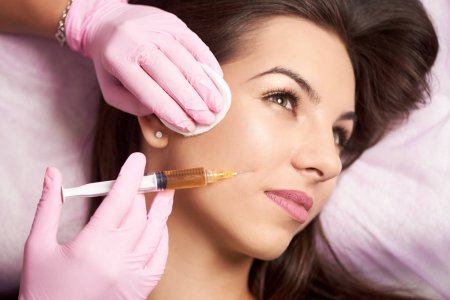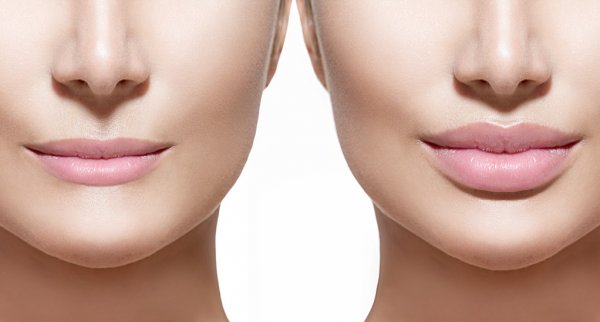Do Fillers Hurt?
 Dermal fillers are one of the most popular ways to look younger without surgery. One question I hear a lot is: do fillers hurt? Although there is a little discomfort, getting fillers injected is much less painful than you may think! Your comfort definitely comes from the application technique, so it matters who you see. Read on to learn what you should know about dermal fillers before getting injected.
Dermal fillers are one of the most popular ways to look younger without surgery. One question I hear a lot is: do fillers hurt? Although there is a little discomfort, getting fillers injected is much less painful than you may think! Your comfort definitely comes from the application technique, so it matters who you see. Read on to learn what you should know about dermal fillers before getting injected.
What are dermal fillers?
Dermal fillers either directly add volume, stimulate your body to make collagen, or do a combination of the two. Our bodies make progressively less collagen, elastin, and hyaluronic acid as we age. The end result is skin with less elasticity and thinner tissue, creating hollowed cheeks and lips that are wrinkled and less full. Fillers restore this volume, thereby counteracting the signs of aging. The end result is smoothing of wrinkles, youthful rounded cheeks, and fuller lips.
Most fillers give an immediate result, meaning you’ll see an improvement when you leave the doctor’s office. The one exception is Sculptra, which gradually builds collagen over a period of about six weeks. Even though the results are immediately visible, you should give fillers a little time to settle after injection. It’s common to have noticeable swelling for a couple days, followed by very mild swelling for up to two weeks. I always recommend patients wait at least that long before judging the final result.
Is there a difference between Botox and dermal fillers?
Botox and dermal fillers actually work quite differently. Botox (and other neurotoxins such as Xeomin and Dysport) paralyze the muscles of the face. This prevents wrinkles that show as a result of frowning, squinting, or raising the eyebrows. Botox is most commonly used over the forehead and around the eyes. Dermal fillers, in contrast, are used to fill out wrinkles around the mouth, add volume to the cheeks, or create fuller lips. Fillers can even be used to make hands look younger, or to smooth out crepey skin on the neck, chest, legs, and arms.
Do fillers hurt?
Getting filler is a little bit uncomfortable, but I have several techniques to make it as close to pain-free as possible. First, I use topical numbing cream to numb the skin prior to injection. We’ve tried numerous formulations from several different pharmacies, and the one we currently use is very effective. Letting the cream sit in place for at least 10 minutes prior to injection makes a huge difference in the comfort level, especially for lip filler.
Second, I apply an ice pack to the area for a few seconds before each injection. Not only does this decrease the pain, but it also constricts the blood vessels to decrease bruising. Finally, I use a nifty little tool called a beauty bar. This gadget is the size and shape of a Bic razor, and when turned on it creates a small vibration. Applying the beauty bar to the skin right next to where I’m injecting distracts your nerves from the sensation of injection. The end result? Less pain.
How long do fillers last?
The longevity of a filler product depends on what it is composed of. Hyaluronic acid fillers like Juvederm, Restylane, and Belotero last an average of 6-9 months. Some specialized formulations can last up to a year. Radiesse is a different type of filler composed of calcium hydroxylapatite. It adds volume as well as stimulating the body to make more collagen, and results last 9 months to a year. Sculptra works entirely by stimulating collagen formation, so it may last a couple years. And there are two permanent fillers on the market: Artefill and Bellafill. I don’t personally use these permanent fillers, because if you don’t like the result there is no way to remove the filler.
With the exclusion of the permanent fillers, your body gradually breaks down the filler material over time. And repeated filler injection does not cause any sort of permanent damage to the skin or soft tissue. So if you decide to stop getting fillers you’ll simply gradually return to your pre-filler appearance.
What should you do after filler injection?
Immediately after filler injection I have patients apply an ice pack for a few minutes to decrease swelling. I also recommend staying well-hydrated and taking a Benadryl or Zyrtec before going to bed to help decrease any swelling. It’s totally okay to wash your face and touch the areas that had filler injected. I don’t recommend any sort of massage unless you’ve had Sculptra- in that case massaging the treated area helps the collagen build evenly and smoothly. It’s okay to work out the same day after having fillers, but you may notice a little more swelling if you do. If you notice little lumps and bumps after filler injection this is almost always swelling, and goes away after a few days. Light massage starting a couple days after your treatment can help the swelling resolve more quickly.
What are the side effects of fillers?
The vast majority of patients only experience mild bruising and swelling after filler injection. You may also notice the area feels a little tender to the touch for a couple days after, especially if you had filler injected in your lips. There are two more serious side effects worth mentioning, however. First, filler is a foreign body, and can develop an infection. I have seen chronic infection in two patients that had filler injected at another office. In both cases it was Juvederm Voluma, a product that is used over the cheeks. The infection is treatable, and treatment involves dissolving the filler, along with antibiotics and steroids to reduce swelling. In my practice I only use Radiesse or Restylane Lyft over the cheeks- I have not seen chronic infection develop with either of these products.
The second serious complication that can occur with fillers is injection into an artery or vein. If this happens in a vessel supplying the skin, the overlying skin will become dusky or blotchy appearing. Without treatment the skin could actually develop a wound. If injection into an artery or vein occurs in the vessels around the eye, the potential result is blindness. Fortunately this complication is very rare. But it is critical that the complication is both recognized immediately and treated appropriately. In my office we have an emergency kit and treatment instructions immediately available in the unlikely event of a serious filler complication. And I and my nurse injector are both trained to recognize this type of complication.
Where should you go to get fillers?
I don’t want to scare you off by mentioning the potential complications of filler injection. They’re the type of thing an experienced injector might see once or twice over her entire career, after treating hundreds of patients a year for decades. The important takeaway point for you is that if you’re considering filler injection, please have it done by a plastic surgeon, dermatologist, or facial plastic surgeon. We not only have the intimate knowledge of anatomy necessary to decrease the risk of such a complication, but we also have the training required to recognize it and treat it. Having filler injected by a nurse or nurse practitioner can also be very safe, as long as they are overseen by a plastic surgeon, dermatologist, or facial plastic surgeon who is immediately available should a complication arise.
Who should not get dermal fillers?
Dermal fillers are quite safe in the vast majority of people. If you are immunocompromised you have an increased risk of infection after filler injection, and should discuss this with your primary care doctor before considering filler. If you have an active infection near the treatment area, such as an infected tooth for example, you should avoid filler injection until the infection has resolved. If you are on blood thinners your risk of bruising is higher after filler injection, but you can still safely get filler injected.
In Conclusion
Dermal fillers are a great, minimally invasive way to look younger. The process is a little bit uncomfortable, but we have some very effective techniques to keep the discomfort to a minimum. In general fillers are very safe. But I do recommend seeing a plastic surgeon, dermatologist, or facial plastic surgeon to decrease the risk of a serious complication. If you still have questions, give us a call (440) 336-8373.

